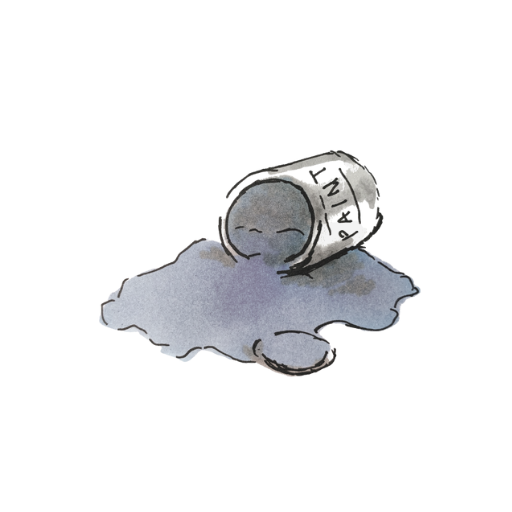
Like many of us, lockdown had me wanting to do all the DIY jobs. The kitchen is one of the rooms in the house that I was happy enough with and we had done very little since we moved in. However, I wasn’t keen on the bright white, super shiny, typical IKEA carcass kitchen we have installed. We don’t currently have the budget for a kitchen refit, so I looked to more creative ways to give the kitchen a makeover. The kitchen makeover is ongoing at the time of writing, but read on to find out how your trusty hairdryer is pretty much all you need to strip laminate from your kitchen cupboards.
Are your cupboards suitable?
First things first, before you strip the laminate from your kitchen cupboards, you need to know what they are made of. The laminate was already peeling away from some of my cupboard doors before I began, so I could see they were MDF doors. My kitchen is a bog standard IKEA carcass with particleboard frames and MDF doors. Only the doors have laminate on them.
You should find out what your cabinets are made of before you strip them, so that you can be sure they will be suitable to paint (you could have chipboard doors, which wouldn’t be ideal, for example).
How to strip laminate kitchen cupboards

All you need is your hairdryer! I am sure a heat gun would do the trick too, but I don’t own a heat gun, so it was hairdryer for me. And let’s face it, it’s not like I need to do my hair at the moment.
It’s incredibly easy, and most importantly, incredibly fun (!) to remove the laminate from kitchen cupboards.
Set your hairdryer to the hottest setting an starting with a corner, use it to melt the laminate adhesive and begin peeling the laminate off.
There is nothing more technical to it than that and it takes about 20 minutes per door.
I chose not to remove the trim around the top of my cabinets. It just felt like a disaster waiting to happen as the screws looked ancient! As the laminate was glued on underneath where the trim attached to the top of the cabinets, I used a stanley knife to score along the edge and then peel the laminate off. I then caulked along the edge to hide the cut and join for a seamless finish (see caulking below in the prep section).
Top Tips
Whilst the stripping itself is not at all difficult, having now done the job myself, I have the following tips for you to get the best finish.
Don’t burn your fingers
The adhesive gets hot and the hairdryer heat is also pretty powerful, so be kind to your fingers. I used a small chisel to ease the laminate off my doors, but any similar tool will do. Just don’t use your fingers!
Don’t force the laminate off
If the laminate doesn’t peel back easily, it isn’t ready. I pulled the laminate off the first door with a bit of brute force and as a result, it took away some of the MDF with it. This is fixable and probably unavoidable to some degree, so don’t worry too much. But minimise damage by only peeling back the laminate when it comes away easily. If you need to force it, then it needs a bit more heat so keep blasting it with the hairdryer until it peels back without resistance.
You don’t need to remove the doors
There really is no need to remove the doors to peel the laminate off. You may have some tricky corners (for example, I have to remove the false drawers from under the sink) but for the most part, you can probably keep them attached. Personally I find this easier as it’s less faff, less mess and quicker.

How to prepare the doors for painting
I spent hours choosing the perfect colours for our kitchen and painting it was like the reward for the prep work. Before you go full steam ahead, the doors will need a bit or prepping and possibly some repair work.
Primer and stainblock
I tried a few options and my preference is a sealer for MDF, and a stain block where necessary. I used Zinsser 123 to stain block (I had some marker pen marks in places on the doors and it has stopped these stains bleeding through the top coat). However, I really didn’t like Zinsser 123 as a primer. It chips and peels easily and is not an effective MDF primer. I would recommend an MDF sealer / primer instead (or a homemade PVA wash).
It’s best to seal / prime MDF before you paint it as it is an absorbent material and can suck in water causing it to swell.
Repair any damage
Even with all the care in the world, you may have some patches that are a little rough and in my case, I lost some small areas of damaged MDF.

I got the smoothest finish possible (and it isn’t perfect, I’ll be honest), by carefully sanding the very damaged bits, priming and applying a coat of my topcoat (I used Little Green Intelligent Satinwood). I left for 24 hours to dry and then smoothed fine filler over the areas of damage as gently wiped it over with a damp cloth. After 24 hours, I sanded back the filler to a smooth finish.

It may be worth repeating this step a couple of times for a really perfect finish. Honestly, I didn’t bother because this is a temporary fix for us and you have to be inspecting the doors pretty closely to even notice. The photos below show close up and a step back. I’m happy with this!


Caulk
I caulked all the edges before painting for a seamless finish. This final touch makes all the difference and is especially handy for hiding any bits of laminate that have been caught in the joins.
Preparation method:
- Lightly sand back any damaged areas (wear a mask and ideally remove the door and sand outside for best ventilation)
- Seal the MDF with an MDF sealer / primer
- Use a stain block if necessary on any areas that could show through the paint (I used stain block over marker pen serial numbers)
- Apply a single coat of your topcoat
- Lightly sand back (fine grit sandpaper)
- Apply fine filler to rough or damaged areas and smooth over with a damp cloth
- Sand back for a smooth finish. It may be worth employing a handheld electric sander for this – it’ll help get a really smooth finish
- Remove any residue ready for painting (a damp j-cloth is your friend!)

Paint the cabinets
Now the fun begins! I loved painting the cabinet doors.

Which paint to use
I would suggest either an eggshell, satin or gloss finish for the kitchen. Eggshell has the lowest sheen and gloss the highest. Matt paint is not really suitable for a kitchen. It will soon get very grubby and is difficult to clean. If you do use a matt paint (and I advise that you do not) then a finishing wax (such as beeswax) will improve durability and make it easier to clean.
I used four coats of Little Green Intelligent Satinwood. It is suitable for kitchen cabinets and hardwearing. The huge variety of colours really sold the paint to me and it is a dream to work with. I used four coats for a really durable finish – coverage is excellent so two would be sufficient.

Brush or roller?
I found a small, round paint brush to outline around the shaker panels and then a mini foam roller to paint the door. I like using a foam roller for a smooth finish, but there’s no right or wrong way to paint. Try paintbrushes, foam rollers and fluffy rollers and you’ll soon find your preference.
I allowed 24 hours drying time between each coat. This gives the paint enough time to properly dry which will ensure a more durable finish.
Between each coat, I lightly sanded back to give the next coat a key. A key is basically a roughed up surface that the paint can adhere to. This also helps with durability.

Painting Method:
- Apply topcoat (this will actually be a second coat if you’ve followed the prep method above)
- Allow 24 hours drying time
- Lightly sand back
- Wipe away residue with a damp cloth
- Apply next topcoat and repeat steps above until you apply your final topcoat (no sanding back required at that point or you’ll sand away the shine!)
For the cabinet frames (which in my case are made of particleboard), I sanded back to remove the shine and create a key for the paint and painted straight on. I didn’t prime, because I’m a maverick like that, but priming is generally recommended! As with all my un-primed IKEA hacks, it’s fine.
The paint will take about a month (yes, a month!) to fully cure. It might feel a bit sticky in this time during this time. Curing is basically hardening up, so you should take care not to be too boisterous with your cupboards during this time. Think of them like a soft shell crab!

How it’s holding up a month after stripping my laminate kitchen cabinets
Absolutely fine! I have no chips or scratches and the satinwood finish is easy to clean. I could not be happier with my new old kitchen cabinets.



1 Comment